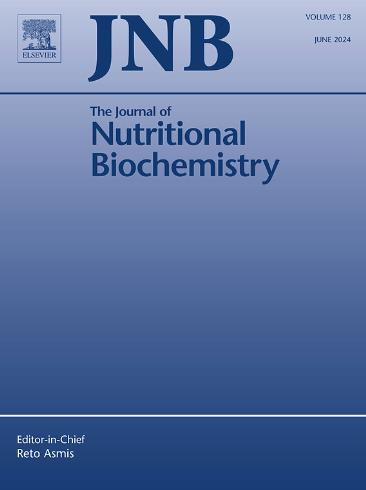在饮食诱导的糖尿病前期雌性大鼠模型中,白藜芦醇对与肝脂质代谢改善和脂肪组织自taxin通路抑制相关的心脏重塑和缺血再灌注损伤的保护作用。
IF 4.8
2区 医学
Q1 BIOCHEMISTRY & MOLECULAR BIOLOGY
引用次数: 0
摘要
前驱糖尿病与心血管风险增加有关,尤其是对女性。最近的证据强调肝脏和脂肪组织(AT)在其分层中的重要性。在这种情况下,目前的治疗策略缺乏心脏保护作用。我们评估了白藜芦醇补充与饮食干预的心脏保护作用,以及它们与高脂高糖饮食(HFS)的糖尿病前期雌性大鼠肝脏和AT改变的关系。雌性Wistar大鼠分为4组,分别饲喂标准饲粮(CTRL)、HFS饲粮(HFS)、HFS饲粮最后2个月添加白藜芦醇(RSV)或HFS饲粮3个月后再饲喂2个月的标准饲粮(RSD)。活体MRI观察心脏形态、功能及灌注情况。通过体外同时测量心功能和31P mrs能量代谢来研究对缺血再灌注(IR)损伤的耐受性,研究肝脂肪变性、肝脏和AT脂质代谢和炎症基因表达。HFS诱导葡萄糖耐受不良、肝脂肪变性、舒张期左室容积、壁厚、心脏重量与胫骨长度比升高,心肌对IR的耐受性改变,功能和能量代谢降低。两种方法都能改善糖耐量,减少肝脂肪变性伴脂质氧化基因表达,改善心肌对IR的耐受性。然而,只有RSV能够抑制HFS饮食诱导的有害心脏重构和autotaxin AT的表达和血浆水平。RSV表现出比RSD更好的心脏保护作用,同时降低肝脏脂肪变性和AT衍生的ATX,表明其对与前驱糖尿病和NAFLD相关的早期心脏改变具有保护潜力。本文章由计算机程序翻译,如有差异,请以英文原文为准。

Resveratrol protection against cardiac remodeling and ischemia-reperfusion injury associated with hepatic lipid metabolism ameliorations and adipose tissue autotaxin pathway inhibition in a diet induced prediabetic female rat model
Prediabetes is associated with an increased CV risk, especially for women. Recent evidence highlights the importance of liver and adipose tissue (AT) in its stratification. Current therapeutic strategies lack cardioprotective effects in this context. We evaluated the cardioprotective effects of resveratrol supplementation versus diet intervention and their association with hepatic and AT alterations in prediabetic female rats submitted to a high-fat-high-sucrose diet (HFS). Female Wistar rats were divided into 4 groups fed for 5 months with: standard diet (CTRL), HFS diet (HFS), HFS diet supplemented for the last 2 months with resveratrol (RSV) or 2 months of standard diet after 3 months of HFS diet (RSD). In vivo MRI was performed to study cardiac morphology, function and perfusion. Tolerance to ischemia-reperfusion (IR) injury was investigated ex vivo by a simultaneous measurement of cardiac function and energy metabolism with 31P MRS. Hepatic steatosis, along with hepatic and AT lipid metabolism and inflammation gene expression, was studied. HFS induced glucose intolerance, hepatic steatosis, higher diastolic LV volume, wall thickness, heart weight to tibia length ratio and altered myocardial tolerance to IR, with reduced function and energy metabolism. Both approaches improved glucose tolerance, reduced hepatic steatosis with lipid oxidation genes expression and ameliorated myocardial tolerance to IR. However, only RSV inhibited deleterious cardiac remodeling and autotaxin AT expression and plasma levels induced by HFS diet. RSV exhibited better cardioprotection than RSD, along with decreased hepatic steatosis and AT derived ATX, suggesting its protective potential against early cardiac alterations associated with prediabetes and NAFLD.
求助全文
通过发布文献求助,成功后即可免费获取论文全文。
去求助
来源期刊

Journal of Nutritional Biochemistry
医学-生化与分子生物学
CiteScore
9.50
自引率
3.60%
发文量
237
审稿时长
68 days
期刊介绍:
Devoted to advancements in nutritional sciences, The Journal of Nutritional Biochemistry presents experimental nutrition research as it relates to: biochemistry, molecular biology, toxicology, or physiology.
Rigorous reviews by an international editorial board of distinguished scientists ensure publication of the most current and key research being conducted in nutrition at the cellular, animal and human level. In addition to its monthly features of critical reviews and research articles, The Journal of Nutritional Biochemistry also periodically publishes emerging issues, experimental methods, and other types of articles.
 求助内容:
求助内容: 应助结果提醒方式:
应助结果提醒方式:


